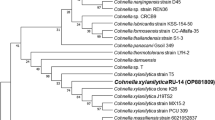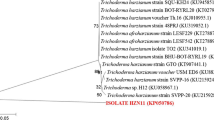Abstract
In the present investigation, significant physical parameters such as incubation time, temperature and pH were optimized for cellulase production by wild and mutant strains of thermophilic Thermomyces dupontii. For a comparative analysis, three independent variables which were selected from OVAT were subjected to RSM. As per response surface methodology (RSM) model, central composite design was used in order to analyze the interactive effects of significant physical factors on cellulase productivity. The second polynomial regression model with a determination coefficient R2 value 0.9503 and 0.9711 was found to be adequate and significant. 3D response surface plots and contours showed interaction among three variables. In contrast to wild T. dupontii, mutant strain showed 1.7-fold increase in FPase activity (43 U/ml/min) at 55 °C and pH 5.5 in 72 h. The result indicates thermophilic mutant T. dupontii has a potential for industrial use, because enzyme obtained from thermophile is more appropriate for industrial process where high temperature is involved.




Similar content being viewed by others
References
Ahmed A, Bibi A (2018) Fungal cellulase; production and applications: minireview. Int J Health Life Sci 4(1):19–36. https://doi.org/10.20319/lijhlz.2018.41.1936
Aiba S, Humphrey AE, Millis NF (1973) Biochemical engineering, 2nd edn. Academic Press, New York, pp 92–127
Alvarez-Cervantes J, Sanchez C, Díaz R, Díaz-Godínez G (2016) Characterization of production of laccases, cellulases and xylanases of Pleurotus ostreaus grown on solid-state fermentation using an inert support. Rev Mex Ing Quim 15:323–331
Bocchini-Martins DA, Alves-Prado HF, Leite RSR, Moretti MMS, Da-Silva R, Gomes E (2011) Agro industrial wastes as substrates for microbial enzymes production and source of sugar for bioethanol production. Integr Waste Manag 1:319–361. https://doi.org/10.5772/23377
Brindha JR, Mohan TS, Immanual G, Jeeva S, Packia Lekshmi NCJ (2011) Studies on amylase and cellulase enzyme activity of the fungal organisms causing spoilage in tomato. Eur J Exp Biol 1(3):90–96
Dutka M, Ditaranto M, Lovas T (2015) Application of a central composite design for the study of NOx emission performance of a low NOx burner. Energies 8:3606–3627. https://doi.org/10.3390/en8053606
El-Katatny M, Somitsch W, Robra KH, El-Katatny M, Gubitz G (2000) Production of chitinase and β-1, 3-glucanase by Trichoderma harzianum for control of the phytopathogenic fungus Sclerotium rolfsii. Food Technol Biotechnol 38:173–180
Gao J, Weng H, Zhu D, Yuan M, Guan F, Xi Y (2008) Production and characterization of cellulolytic enzymes from the thermoacidophilic fungal Aspergillus terreus M11 under solid-state cultivation of corn stover. Bioresour Technol 99:7623–7629. https://doi.org/10.1016/j.biortech.2008.02.005
Gorems W, Alemu T (2014) Production and optimization of cellulase from Trichodrma isolates under liquid state fermentation. Ethiop J Sci 37(2):131–142
Gupta C, Jain P, Kumar D, Dixit A, Jain R (2015) Production of cellulase enzyme from isolated fungus and its application as efficient refining aid for production of security paper. Int J Appl Microbiol Biotechnol Res 3:11–19
Hebeish A, Hashem M, Shaker N, Ramadan M, El-Sadek B, Hady MA (2009) Effect of post- and precrosslinking of cotton fabrics on the efficiency of bio finishing with cellulase enzyme. Carbohydr Polym 78:953–960
Inoue H, Decker SR, Taylor LE, Yano S, Sawayama S (2014) Identification and characterization of core cellulolytic enzymes from Talaromyces cellulolyticus (formerly Acremonium cellulolyticus) critical for hydrolysis of lignocellulosic biomass. Biotechnol Biofuels 7:151. https://doi.org/10.1186/s13068-014-0151-5
Irfan M, Javed J, Syed Q (2011) UV mutagenesis of Aspergillus niger for enzyme production in submerged fermentation. Pak J Biochem Mol Biol 44(4):137–140
Khandoker N, Al Mamun A, Nafiz TN, Khan SN, Hoq MM (2013) Strain improvement of Trichoderma viride through mutation for enhanced production of cellulase. Bangladesh J Microbiol 30(1–2):43–47. https://doi.org/10.3329/bjm.v30i1-2.28452
Khare A, Upadhyay R (2011) Influence of some cultural factors on production of cellulase and β-1, 3-glucanase by the mutant strains of Trichoderma viride. J Agric Technol 7(2):403–412
Mai AB, Burah B, Milala M, Abbas MI (2018) Isolation, production and optimization of cellulase from a combination of Aspergillus niger and Trichoderma viride isolated from decaying woods. Int J Biochem Physiol 3:1–6. https://doi.org/10.23880/ijbp-16000139
Meena SS, Sharma V, Gupta S (2018) In vitro optimisation of fungal cellulase production from fruit waste for handmade paper industries. Biotechnology 17:35–43. https://doi.org/10.3923/biotech.2018.35.43
Miller GL (1959) Use of dinitrosalicylic acid reagent for determination of reducing sugars. Anal Chem 31:426–428
Mmango-Kaseke Z, Okaiyeto K, Nwodo UU, Mabinya LV, Okoh AI (2016) Optimization of cellulase and xylanase production by Micrococcus species under submerged fermentation. Sustainability 8(11):1153–1168. https://doi.org/10.3390/su8111168
Mrudula S, Murugammal R (2011) Production of cellulase by Aspergillus niger under submerged and solid state fermentation using coir waste as a substrate. Braz J Microbiol 42:1119–1127
Nair AT, Makwana AR, Ahammed MM (2014) The use of response surface methodology for modelling and analysis of water and wastewater treatment processes: a review. Water Sci Technol 69(3):464–478. https://doi.org/10.2166/wst.2013.733
Nochur SV, Roberts MF, Demain AL (1993) True cellulase production by Clostridium thermocellum grown on different carbon sources. Biotechnol Lett 15:641–646
Prajapati VS, Trivedi UB, Patel KC (2015) A statistical approach for the production of thermostable and alklophilic alpha-amylase from Bacillus amyloliquefaciens KCP2 under solid-state fermentation. 3 Biotech 5:211–220. https://doi.org/10.1007/s13205-014-0213-1
Priyanka P, Yuvraj C, Farha S, Aranganathan V (2017) Isolation of cellulose degrading fungi from soil and optimization for cellulase production using carboxy methyl cellulose. Int J Life Sci Biotechnol Pharma Res 7:56–60
Rao UMJL, Satyanarayana T (2003) Statistical optimization of a high maltose-forming, hyperthermostable and Ca2+-independent alpha-amylase production by an extreme thermophile Geobacillus thermoleovorans using response surface methodology. J Appl Microbiol 95(4):712–718
Santoshkumar S, Sujatha E, Shivakrishna P (2016) Production and optimization of exo and endocellulases from thermophilic fungi Scytalidium thermophilum SKESMBKU02. Walailak J Sci Tech 13(1):9–22. https://doi.org/10.14456/WJST.2016.2
Saroj A, Hemant S, Bhanu PP, Naveen K (2017) Isolation and screening of thermophilic and thermotolerant fungi for production of hemicellulases from heated environments. Mycology 8:125–134. https://doi.org/10.1080/21501203.2017.1337657
Saroj P, Manasa P, Narasimhulu K (2018) Characterization of thermophilic fungi producing extracellular lignocellulolytic enzymes for lignocellulosic hydrolysis under solid-state fermentation. Bioresour Bioprocess 5(1):17–31
Shah IJ, Gami PN, Shukla RM, Acharya DK (2014) Optimization for α-amylase production by Aspergillus oryzae using submerged fermentation technology. Basic Res J Microbiol 1(4):1–10
Vijayaraghavan P, Rajendran P, Vincent P, Gnana S, Arun A, Abdullah Al-Dhabi N, Kim YO (2017) Novel sequential screening and enhanced production of fibrinolytic enzyme by Bacillus sp. IND12 using response surface methodology in solid-state fermentation. Biomed Res Int 1:2. https://doi.org/10.1155/2017/3909657
Author information
Authors and Affiliations
Corresponding author
Ethics declarations
Conflict of interest
The authors declared there is no conflict of interest associated with this work.
Rights and permissions
About this article
Cite this article
Nisar, K., Abdullah, R., Kaleem, A. et al. Statistical Optimization of Cellulase Production by Thermomyces dupontii. Iran J Sci Technol Trans Sci 44, 1269–1277 (2020). https://doi.org/10.1007/s40995-020-00932-1
Received:
Accepted:
Published:
Issue Date:
DOI: https://doi.org/10.1007/s40995-020-00932-1




